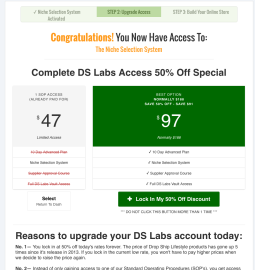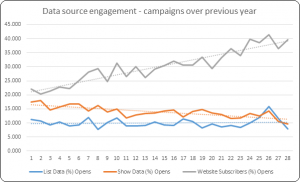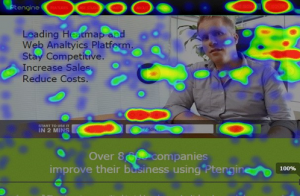Ready to grow your business? Here are some high-level ideas to get you started NOW.
Owning a business is like running a fantasy football team, you always look forward to Mondays.
Once you taste a little success, you want growth. And when you’re chasing after that growth, you often fall in love with the journey. They say the chase is the fun part anyways, right?
Reading business websites like Forbes is not enough to take your business to the next level. You need to take action.
If you plan on achieving some hockey stick growth in the near future, then you’re in the right place. I’ve spent the last decade building and selling businesses, but I’m not here to talk about myself. I’m here to help you grow your business as much as possible…
Business growth only happens in three different ways:
- Getting more customers. The more people that buy, the more money you make.
- Raising your prices. You’ll make more money off of each transaction.
- Improving your conversions. Increasing the frequency that your average customer buys from you and getting each customer to buy more often.
This post will cover all three. And even if you aren’t as far along with your business, this post will give you the ingredients to scale quickly and efficiently whenever you are ready.
Are you ready to scale your business? Let’s dive in.
1. Repair Your Sales Funnel
The first and arguably the most important factor when it comes to scaling your business is your sales funnel. If you haven’t thought long and hard about your sales funnel, then (July 04, 2016) is the perfect time to start.
Also referred to as a customer acquisition funnel, your sales funnel is the ideal process that takes customers from being a prospect to being a paying customer. It’s what takes you from seeing a random ad on Facebook to reading a blog post to receiving a free Ebook and then to finally making a purchase.
Think of your sales funnel like a real funnel (I know this is hard because I’ve never owned a funnel, but let’s pretend). The more leaks your funnel has, the more customers spill out along the way. The stronger your funnel, the less spills you have, and the more money you earn.
If you haven’t examined your funnel, chances are there are MANY leaks that you don’t know about. Most funnels work something like this:
Traffic → Free Content (lead magnet) → Helpful Free Content → Email Follow Up → Sale
To be honest, all of my businesses used to look like that as well. Then we realized we were leaving a ton of money on the table.
Here are some mistakes that we’ve made over the last few years that I see a lot of other businesses making as well.
Too many steps in the funnel: You can only ask people for something so many times until they say no. If you have many steps in your funnel and looks something like the following, then you’re losing sales:
Paid traffic → FB page → free content → email opt-in → $ 10 product → $ 25 product → Webinar → $ 100 product → $ 700 product
Each step is going to yield a dropout rate. The more steps, the more people will drop out. It’s as simple as that. The more steps, offers and products in the funnel, the more people are going to say “no” and once they’re gone, it’s difficult to get them back. It’s better to have a tighter funnel that consists of 2-4 steps and to retarget people who have dropped out.
While too many steps can be a bad thing you also need to make sure you are careful of having…
Not enough steps: Have you ever walked into a random store for the first time and bought a product you had never heard of for $ 3,000? I’m not sure about you, but I’ve never done that.
The internet works the same way. If your product is $ 1,000 or more, do you expect your customer to make a purchase after reading two blog posts? I hope not.
You need to have a tripwire, or a low dollar product that gives people the option to make a low-risk choice and test your company out. Once they buy from you, if they like what they’ve bought, they’ll be more likely to use that credit card again and buy your more expensive products.
We’ve played around with our tripwires, pricing things at as low as $ 7 and as high as $ 97. It really depends on your product and how familiar people are with your brand, but I definitely recommend testing this out for yourself.

Too many funnels: At one point, Drop Ship Lifestyle had four different funnels with four different lead magnets and four different tripwires. In practice, this sounded great, but we quickly realized that it was extremely confusing to people that were opting in.
Sometimes people would want to buy cheaper products that weren’t offered in the original funnel that they opted in to. Other times, people were confused by the different courses and it was unclear which courses were free and which ones were paid.
The more funnels you have, the more products you need, the more email autoresponders you need, the more segmenting you need to do within your CRM software (more on that in a minute). Basically, it means that your headache potential is high.
It’s better to have one strong funnel that works than four funnels that are subpar. It also takes time to figure out how well a funnel is performing. It can take an extremely long time, especially with…
Not enough leads: Trivia time: What do you call a broken escalator?
(If you’ve watched Mitch Hedberg, you’ll know the answer…)
Answer: Stairs!
Okay, I’m sorry if you didn’t laugh….
Try to think of your funnel as an escalator, taking your leads from nothing all the way to the top floor (that’s where you make the sale). If it breaks, it becomes stairs, and nobody will move, and they’ll leave entirely and look for the elevator (which is your competitor!). If you want proof that your escalator is working efficiently, you need to get a lot of people on board.
In order to know if your funnel is working, you need to send a lot of traffic through it. Without testing it, you’ll never know, and it’s difficult to tell whether or not a funnel is converting without enough data.
“What’s enough data?” This depends on your price point (which should reflect your budget), but we aim for at least 1,000 new leads to send through a funnel (for a product that’s around $ 1,000) before we analyze it and see if it’s working or not.
If you’re only getting a few dozen leads per day, you’re not able to make strong observations on what’s working and what’s not. It also slows down your entire business if it takes a full month to realize that the funnel isn’t breaking even.
The solution? Use paid traffic (we prefer FB ads but there are plenty of ways) to get more leads so you can test your funnels within days instead of weeks.
Another big mistake many businesses make is that they…
Don’t ask for the sale: I see a lot of businesses shy away from asking for more. They’ll have a great lead magnet with a great opt-in offer, but once I opt-in, they stop asking. If they don’t ask me to check out their products or visit their latest blog post, I won’t, and then the interaction stops there.
Instead, you want each step in your funnel to always include an upsell. If they buy an inexpensive product, offer them an upsell on a more expensive product on your thank you page.

Here’s one of our thank you pages. Right after they bought a $ 47 product, they are given the option to buy a $ 97 product.
If they read a blog post or watch a video, ask them to sign up for your lead magnet. If they give their email address, ask them to buy your product.
If someone stumbles on your website for the first time, you want to give them the opportunity to slide down your funnel as far as they’re willing to go. If you don’t offer them an upsell after each step, then they’re not going to make it as far. It’s that simple.
On another note, I see a lot of companies that don’t go after the sale hard enough. I’m not saying you need to be extremely aggressive, but if you aren’t pushy and never get rejected, then someone else will get the sale and not you.
At a business conference I attended last year, I learned that there’s a positive correlation between how much a business makes and how long their email autoresponder is. One business claimed their email autoresponder lasted for over a year! It makes sense that they are a multi-million dollar company, because when you stop sending emails, your chances of making the sale drops to 0%.
But don’t get too busy trying to make the sale, as some point, you’ll need to take a step back in order to…
Review your funnels. Automated funnels are great, right? Once you set up everything, you can just plug and play and then never have to think about it again, right? WRONG.
If you’re not reviewing your funnels, you won’t know which ones are performing well and which ones are actually making you money. Assuming you are paying for traffic, you need to review your analytics and make sure that your funnels are profitable.
For example, back when our company had four funnels, when we looked at the numbers, we realized that one of the funnels simply was not converting.
Meanwhile, one of our funnels was converting FAR better than the rest, so we shut down the weakest funnel completely and started sending more traffic to the lead magnet that had the highest conversion rate.
This opt-in page had a 40% conversion rate, which is pretty good.
This one had a 1% conversion rate. We no longer send traffic to this page.
If you have more than one funnel (and you should), then make sure to mark your calendars and schedule time to review them and make sure they’re all running profitably and efficiently. You will probably find that you’ll need to cut and increase spending according to performance
Alright, now that we’ve got our funnels behind us, time to move on to the most overlooked aspect in funnels today…
2. Live Webinars

As you can see, live webinars have been a very profitable tool.
If you haven’t hopped on the webinar train yet, then you’re doing yourself a disservice. It took us two years to start doing them regularly, but now that we’ve found a system that works, we’re not slowing down anytime soon.
Webinars work well for many reasons. They’re personable, focused, engaging, scalable, and fun. I still think it’s so cool that I can hop on a call from Vietnam and talk to people in all corners of the world all at once. Oh, and it’s FREE (for attendees).
Anyone who signs up is clearly interested in the topic, so none of your leads are completely cold. We make sure that our webinars are filled with more information than any of our lead magnets, and by doing the presentation in real time, it gives us a lot of credibility and trust. Sure, sometimes people don’t show up or you experience technical difficulties, but we’ve found ways around these issues through sending follow up emails, replays, and an email with the subject line “For those of you who hate webinars…” to address this.
I’m not talking about the same webinar strategy that you’ll read in books about recording one, replaying it, and letting it act as an automated sales funnel. Ours are different. We do them live, and we do more than one. I already wrote more about funnels than I originally intended, so in order to keep this post from being 5,000+ words, I’ll save the webinar details for a future post.
3. Private Facebook Group
Having a Facebook group where people can connect and chat is valuable. I’m not sold on pushing your leads to Facebook (it’s distracting as we all know!), but the important part here is that you have somewhere to push your leads to.
Sure, perhaps they can comment on your blog post, but how often does that turn into a conversation weeks down the line? How often will your question get answered by someone else? If you have a huge blog with a loyal fan base, then sure. But if not, it’s better to direct people to one casual group that you control.

Public accountability works well and FB groups are a great way to do that. We also have current customers answering questions by saying, “Buy the full course,” which is incredible.
Our Facebook group is getting more active by the day, and people are starting to help each other out as well as promote our most expensive products for us! It’s a great way to maintain a community without much maintenance.
Plus, since it’s on Facebook, nobody expects it to be extremely formal, so you can treat it however you like. If people ask questions, you’re able to provide value publicly, which not only helps others with the same questions but helps you gain trust. Everyone spends hours on Facebook everyday mine as well give them the chance to be productive.
Obviously, there are better ways out there to communicate than Facebook, which takes us to our next point…
4. Don’t Just Build An Email List, Engage

This should be obvious, but if you’re not building your email list, you better get going. If you’re not sure why then you should probably revisit this blog when you are further along in your business.
The bad news is that you should have already started building our email list, the good news? If you’ve built a business without one, then your potential for growth is enormous.
If you’ve just started to collect email addresses, it’s time to double down on your lead magnet and get more. Having an email list is incredibly valuable. As of March 2016, my biggest email list is 84,914. We’re currently getting a few hundred leads a day, so this number is only growing.
It took over three years (and a lot of money on paid traffic) to get it to that number, so don’t be discouraged if you’re just starting out.
Once you get an email address, it’s a waste of time and money if you don’t engage. You need to be sending frequent emails to your list, and your emails need to be engaging and valuable. If you send email blasts every other day selling your products without providing value, then people will stop opening your emails.
In your emails, make sure you’re solving a problem or at the very least entertaining people.
Here are a few of the types of emails we send out to our list:
Indoctrination Sequence: Once people opt-in, we send them through an indoctrination (or welcome) series. In these four emails, we ask them several captivating questions helping people open up. This gives us AMAZING data (the more we know about our customer’s problems, the easier it is to solve them) and also makes it clear that we want to build a relationship. It’s WIN-WIN.
Lead Magnet Autoresponder: These emails provide people with the FREE lead magnet they signed up for, but also adds a little spice to it. We provide advice on how to use our products better, try to answer their questions, and hit on the challenges that we know they are going through at this given time. These continue the relationship and keep us fresh in their minds.
Webinar Sequence: Webinars are like icebergs. The majority of the work goes unseen, and when done right, they help you make A TON OF MONEY (Titanic, anyone?).
For every 60-minute webinar, we send 2-3 emails promoting the webinar, two more reminder emails to those who signed up, and then 5-10 follow-up emails to those who attended and 5-10 for people who missed the webinar. It’s a lot of emails (luckily I have someone on board who helps me write them), but it’s definitely worth it.
Newsletter: Once people join our community and buy our product, we continue to provide value to them by sending them monthly newsletters. This varies depending on your business model, but it’s not a bad idea to continue the relationship after people have bought your product. If your business has a recurring billing model, then you need to be sending newsletters/updates.
Our newsletters’ sole purpose is to help our current customers even more. We want to remind them they made the right decision (buying our course) and motivate them. The ROI on this isn’t immediate, but our customers love hearing from us.
Broadcasts: This is usually for people who haven’t bought. You would expect these broadcasts to be filled sales pitches, right? That’s the OPPOSITE of what we do. Broadcast emails are for big announcements and FREE content. We send out blog posts (like this one), podcast interviews, videos, and other helpful content that is completely free.
(In future posts, we’ll be going into more detail on how to craft great emails, when to send them, and more.)
You might be thinking, “Wow, this is a lot to keep track of. How do I organize this?”
5. A is for Apple, C is for CRM
For those of you who forgot, CRM stands for customer relationship management. Why is CRM important? Because if you want to scale your business, you need to care about your customers. That means tracking who bought what and studying the metrics.
Since we’ve upgraded our CRM software and have paid more attention to it, we’ve been able to pinpoint which funnels perform well (see #1), which emails have the highest open rate, and which steps people are dropping out on. It enables us to maintain an overview of how everything takes place, which helps us stay organized and keep tabs on every lead and customer that comes our way.
We used to use Ontraport and now we use InfusionSoft. Both have worked well for the most part. Having either will help you segment your email list so you can track who you’re talking to and tag them appropriately. One of our goals in the upcoming year is to start optimizing our CRM tracking, so stay tuned.
In the meantime, if all of this sounds overwhelming, no need to worry, it’s time to…
6. Delegate Like It’s Your Job (it is)
A lot of business owners suffer from what I call “superman syndrome”. They think they can do everything themselves. They write their emails, run their ads, do podcast interviews, and more. They’ve thought about hiring help, but they’re either too cheap or too scared that if they delegate it, it won’t get done properly.
These fears as a business owner are rational, but they are still holding you back from scaling. If you want to grow your business, you need to work on your business, not just in it. Even though you think you’re the best at writing your sales copy or running your Facebook campaigns, it’s not the best way to spend your time. Plus, there are experts out there that can do it better than you. Sorry, superman.
Hiring can be a scary thing, so it’s important to be careful when bringing on new team members. While hiring someone to replace you right now may seem like a step backward, in the long run, it’ll definitely be a forward LEAP if you do it right.
Hire people that will do their job better than you can do it. For example, our tech guy knows way more about landing pages and analytics than I do. Our paid traffic girl knows WAY more about Facebook ads than I do, and our content writer is far more creative than I am (he wrote that line but I let him keep it in because it’s true!)
Instead of writing the content myself, running the ads, and then checking the data, I leave it to my team, allowing myself to focus on growing the company while they maintain it.
Some people feel like they need to touch every single aspect of the business in order to be confident that it’s running well. Here’s a good rule: if you can hire somebody who can your job 90% as well as you can, then do it.
You’re not going to find someone who can do it as good as you right now. But if you hire them now and it is their full-time job to get better at that skill, sooner or later they’ll be able to do that task better than you.
7. Pay For Traffic The Right Way
In order to get paid traffic right the first time (which is what you want because it means not wasting tons of money), you’ve got to mull over the following core questions:
The first question you should ask yourself is, “Who is my target audience?”
If you’re selling arch-support heels for old ladies with calluses, you’re probably not going to want to target Male’s age 18-24.
Brainstorm and figure out who actually WANTS or NEEDS your products. Then, write it all down. You need to make your very own avatar. No, not the blue kind from Pandora, a customer avatar of your ideal customer.
What’s his/her age? What do they do in their free time? How much money do they make? What is their job? You should even give him/her a name. This is your ideal customer, and this is who you should target.
The next question you should ask yourself is, “Where does my target audience hang out?”
Are they Facebookers, Redditors, Tweeters, Youtubers? Just about every social online hangout space has the ability to advertise.
Or maybe they are some serious old school folks that aren’t on social media? If that’s the case, they probably browse news outlet websites or check what disease they just obtained with WebMD, so you can still target these folks with platforms such as Google Ads.
Or, perhaps your ideal audience is stuck in the early 2000’s with their Yahoo! Browser… well, guess what? You can advertise with the Yahoo! Ad Platform called Yahoo Gemini!
You definitely need to be thinking about where your audience actually IS on the internet, and then digging further to see how you can speak to them in the places they ALREADY visit. (Don’t worry we will cover more on each Ad Platform, and how to use each, in the future)
The third and final question we’ll cover here is, “How do I speak to my target audience?”
When you are asking your target audience for their email address in exchange for a free download or another lead generator, you need to be able to adequately speak to this person in his/her language.
You need to be able to persuade them to give you their email address through text alone. This isn’t always easy.
There a few ways in which we prefer to do this.
- Tell your audience what they are going to get/gain out of giving you their email address.
- Use emotions, tell your audience how this lead generator will inspire them, or make them better at their life or job, etc.
- Ask yourself, “How will this download make your target audience’s life easier? Or how it make their life more efficient?” Then spell it out in words that they use.
- Finally, show your target audience proof. What have others accomplished by using this Lead Generator? What have others said about your program or business?
Ask yourself these three core questions before you jump on to any Ad Platform, and if you answer each one truthfully and tailored to your business, you should see a high ROI.
On top of paid traffic, it’s also a good idea to…
8. Content Market Like a Queen
One area you should definitely be delegating is content marketing. Why? Because it’s extremely time-consuming. Sure, every now and then you can write a new email or blog post, but if you are going to produce content on a regular basis (which you should), you should bring someone on board or hire an agency to help out.
“What kind of content should I make?”
If your content is not helping the reader, it’s not going to help your business. Your content needs to be valuable and easy to follow.
As far as what platform to use, here are some options with some pros and cons, but remember, engagement is what matters most:
Blog: Blogging is not dead. Not even close. If it were, do you think we’d be publishing this post right now? Blogging is great because it’s easy to set up and get going, but writing is hard and takes time to put out an in-depth post. That’s why we have a content creator on board.
It took Jeremy several hours to write and edit this post, while it took me less than twenty minutes to read through it and add my two cents. We’ll be going over our exact blogging process and how we get the most out each article down the line.
Social Media: I’ll admit, we don’t do a very good job at this. But that’s okay, because I’m proud to say that we are not spread too thin. We don’t use Twitter, SnapChat, or Instagram. We have a Facebook page, but we don’t have a posting schedule, we just wing it. Social media is a great way to engage with your customers and to do so FAST.
One issue with this is people’s’ attention span keeps getting less and less. The problem here is that you can’t half-ass social media. If you’re on Twitter, people are going to expect you to respond within minutes rather than days. We plan to experiment with this in the future as we grow.
YouTube: This is another area that we haven’t focused on recently, but I’ve seen a lot of companies have success with it. We are able to get leads for extremely cheap by advertising on other YouTube channels and sending them back to our channel. Then, once they watched one of our videos, they are able to opt-in to our lead magnet (shown below).

We don’t put out new YouTube videos anymore, but having a backlog of videos definitely gives us credibility. The great thing about content is the more you have, the easier it becomes to backlink and cross promote. We link to YouTube videos in your blog posts all the time, letting people consume as much context as possible until they are ready to buy.
The blog has been our main focus since late 2015, but that may change if I decide to start a video blog. Those are becoming more and more popular, but I’m not sure if I want to be on camera that much. Plus, vlogs require a lot of work, and the main reason I haven’t started one yet is because in order to grow a business, you need to…
9. Focus. Focus. Focus (Your Products)
Don’t fall into this trap. The main reason Drop Ship Lifestyle continues to grow and succeed is because the main product has not changed over the years. Sure, we’ve updated the courses, improved the videos, and added information, but the coaching program we sell today is the same 7-module video course that it was in 2013 when we launched.
Similar to your funnel, if you complicate your business by adding too many products, it can lead to a lot of confusion. Adding products and levels can sound appealing, but it can do more harm if it’s not done correctly.
Over the years, we’ve been able to raise our prices because we’ve improved our course and made it better by trimming a ton of fat and making it easy to consume. We didn’t try to add on an upsell of products that were semi-related. We’ve grown because we’ve made sure our product is the best ecommerce course on drop shipping out there and then we focused a ton of energy marketing it.
Notice we didn’t just raise the price randomly, we increased the price while adding more value and improving the product. If you want to charge more, you’ve got to bring more value to the table. The best way to do this is to provide additional products or services that helps people get their desired result faster. Que the segway…
10. Go Premium or Go Home
If you’re familiar with the 80/20 principle, then you can assume that 20% of your customers will generate 80% of your sales. It sounds impossible, but it’s pretty accurate. Especially when you offer a premium product.
As we mentioned earlier, when you offer premium, you need to add value along with the price tag. Here are some examples on how to make your product premium:
- Offer done-for-you services (For example, DSL builds you a website if you go premium)
- Offer 1-on-1 coaching/training
- VIP treatment (people love to think they are “special”)
- Adding additional products (guides, conference tickets, etc.)
- Expedite (if you offer a service, deliver the results faster)
- Warranties
- And more…
People with a lot of money are used to paying for convenience. So, if you offer a high priced product as it is, chances are there are few customers out there that would pay double, triple, or even quadruple that. It’s up to you to figure out how to provide more value.
11. Build a Public Profile (because people care)
In the age of the internet, it’s never been easier to establish a relationship with your customers. It baffles me how so many business owners still hide behind their laptops and never make an attempt at getting personal.
Since you’re the leader of your company, other people want to know you. The same way we want to know Mark Zuckerberg and Bill Gates. It’s not always easy to be the figurehead, but you just have to do it.
I still don’t like getting in front of the camera, but I do it because I know people like it and I know it works. I’m sorry if you are shy and don’t like the attention. It’s your business so it’s your problem.
I laugh at all of the business websites I come across where you cannot find even the basic information on the founder/leader of the business. If your approach is to stay behind the scenes, hire a CEO who can fill your shoes or rest well at night knowing you are selling yourself short.
Get in front of the camera and record some videos every once in awhile, sign your name in the emails, and don’t be afraid to be personal. People like buying from people more than businesses. Remember that.
If you can remind your customers that behind every product and every pitch there are real people, they’ll be more likely buy. Share your experiences and tell your story. People appreciate authenticity.
12. Think Big. Then Bigger

This seems cliché, but the main reason your business isn’t growing could easily be your mindset. Are you comfortable where you currently are, making a few hundred thousand per year?
It’s easy to slip and plateau if you’re not surrounded by the right type of people and the right team members. If that’s you, make sure you set some ambitious goals and surround yourself with people who are going to hold you accountable or help you achieve them.
You’d be surprised how many people don’t actually aim high because they assume there is too much competition. It’s actually the opposite. There’s less competition the further up you go, because most people don’t want to fight to get there. If you’re going to dream, you mine as well dream big
Become a High-Performance Marketer
Alright, I know this wasn’t exactly a short post, so if you made it until the end I hope you got a lot of value out of this. We’re going to be publishing two posts each month, so please subscribe if you haven’t yet. We’re also going to be opening up a community soon, so stay tuned for that.
We’ll be sharing our launch formulas, our detailed approach to paid traffic, our webinar secrets, and more, so make sure you enter your email and check back soon!
If you know a friend who would benefit from this post, make sure to send it their way!
Business & Finance Articles on Business 2 Community(91)
Report Post






